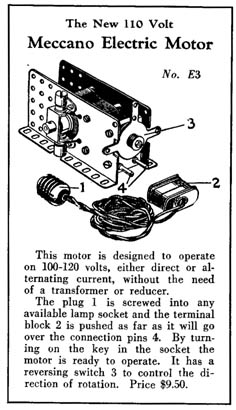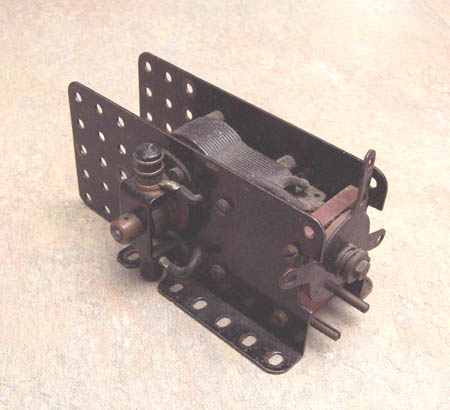US Meccano Motors
| Type |
DMS # |
Size |
Top |
Cutout |
Flange holes |
Brushes |
Commutator |
Shaft dia. |
Pole piece |
Plate thk |
| A |
2028 |
2" x 5" |
stepped |
square |
round |
outside |
disk |
.111" |
straight |
.050" |
| B |
2028A |
2" x 5" |
stepped |
none |
oval |
outside |
disk |
.112" |
arched |
|
| C |
none |
2" x 5" |
straight |
none |
oval |
outside |
disk |
.120" |
arched |
.048" |
| D1 |
none |
2" x 5" |
straight |
none |
oval |
inside |
drum |
.112" |
arched |
.051" |
| D2 |
none |
2" x 5" |
straight |
none |
oval |
inside |
drum |
.112" |
arched |
.032" |
| E |
2038 |
2" x 3" |
straight |
none |
oval |
inside |
drum |
.112" |
arched |
.032" |
| F |
none |
2 1/2" x 5" |
straight |
none |
oval |
inside |
drum |
.160" x2 |
arched |
.047" |
| G |
2020 |
110 volt not seen |
| H |
none |
Gilbert |
(Standard Meccano shafts are .160" diameter) |
Type A illustrated from 1915 through 1921
Type C illustrated in 1922 catalog
Two types of brushes are mentioned as early as 1924
See picture for difference in brush mounting and other holes between D1 and D2
Type D2 illustrated in Mar-Apr 1926 US MM, but illustration is retouched (perhaps from English motor?)
Type F illustrated in 1928 and 1929 catalogs only; mechanism same as D2, except shaft diameter and shaft extends on both sides.
 
The December 1926 issue of the Meccano Magazine (US version) illustrates the new 110 volt motor (see above). This is illustrated in Love & Gamble on page 109, but other references (DMS, EMP) indicate that the motor was available in England before it appeared in the US. In any case, the motor is only listed in the US Meccano Magazine and in a late 1926/ early 1927 advertising booklet, "How Jack Discovered the Perfect Toy" (the same text as in the booklet was in the same issue of the MM). It is interesting that this motor had so little mention in the US literature. One suspects that perhaps it was too dangerous for US regulations, and was not distributed here. The picture above is of a French Meccano 110 volt motor, purchased in England by my Dad sometime in the 1920's. The motor is marked "MOTEUR MECCANO / 110 Volt / 2500 TOUR / FABRIQUE EN FRANCE". Note the difference in the flanges, and the home repair on the brush cap.
The 2" x 3" motor (reference E) was apparently only used in the 1929 No. 5 Special outfit. It is not shown in any other outfit or year, at least in the US. It is not listed as a separate part, either. This motor was too small to accommodate a reversing switch, so it was only available in non-reversing style. It appears to be a reference D motor cut shorter at both ends; all of the holes match, and (unlike the catalog illustrations) it has sharp corners instead of the rounded corners on all previous motors. In a return to earlier practices, it was sold in England, apparently exported from the US, in 1930 (see Love & Gamble, pg. 112). It is easy to guess that this motor had been developed before Gilbert bought the Meccano Company, and he wanted to use his own motors. These small Meccano motors then became surplus, and were shipped back to England. This motor then continued in production (presumably in England) until around 1940 (EMP).
One final "Meccano" motor should be mentioned. When Gilbert changed the Meccano line in 1930, he used many Erector parts instead of Meccano. One of the substitutions was the motor, but it was not exactly the Erector motor used in the Erector outfits. While the smaller motor looks a lot like the Erector P58, it is slightly different: the "Meccano" version has no "feet" at the bottom. This allowed it to be mounted between perforated plates, in a manner very similar to the long-standing Meccano motors. The old Meccano models could be built with no (or very little) modification. These sideplates (Gilbert-Meccano part 173 R & L) even retained the small slot for mounting the reversing switch used in the "real" Meccano motors, although no such switch was available from Gilbert. |